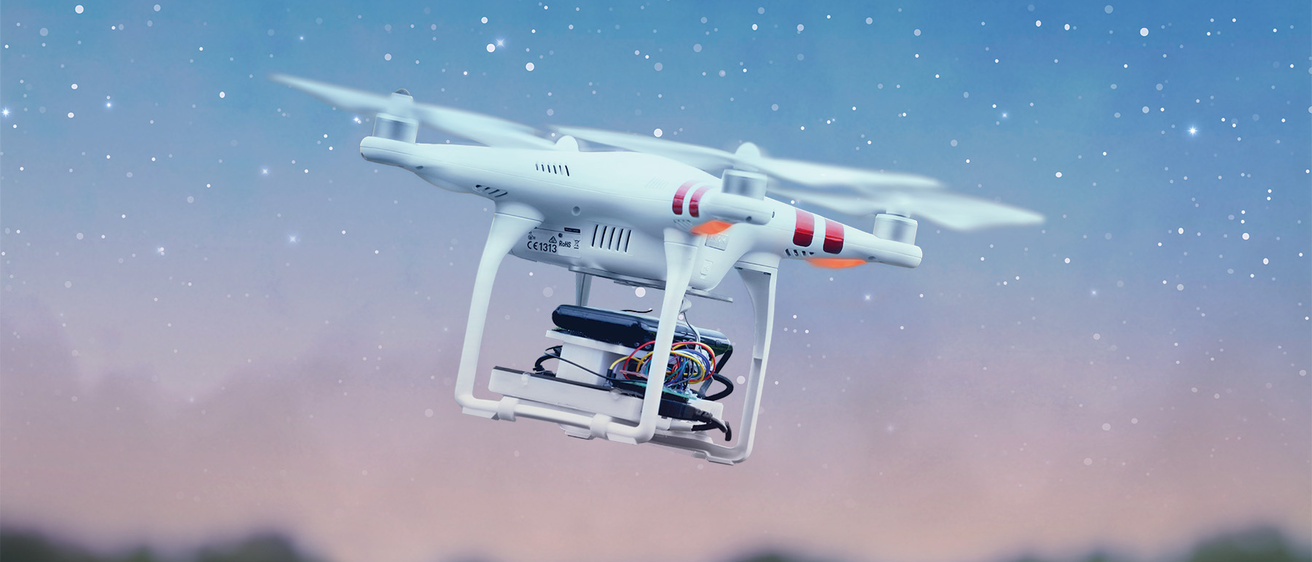Aspiring scientists touched down at the University of Iowa for the Edge of Space Academy, an immersive course fueled by a legacy of astrophysics research.
Story: Richard C. Lewis
Photography: Justin Torner
Videography: Matt Jansen
Published: Jan. 26, 2023
For two weeks over the summer, the University of Iowa was Mission Control.
Undergraduate students from across the United States came to campus last July, enticed by the prospect of stewarding a mission to explore Earth or space. The students were the first group to enroll in a new class, called the Edge of Space Academy, offered by Iowa as another marker of its living, breathing legacy in space-based research.
In an intense, compressed time frame, the students would seek to plan and complete their own mission, just like full-time scientists involved in real-life NASA exploratory journeys. Along the way, they would learn how to build instruments, assemble electronics, create computer code, operate a payload, guide a drone operator or a jet pilot, collect and analyze data, and report results to decorated scientists and stalwarts in their fields.
Perhaps most importantly, they would learn what it’s like to succeed — or fail.
DURING THE ISOLATING DAYS of the COVID-19 pandemic, a faculty group devoted to space research dreamed up ideas to advance Iowa’s reputation in Earth and space instrumentation. The winner: a class to bring undergraduates to Iowa, introduce them to the university, and give them the full flavor of a science mission.
“We have a lot of great faculty and researchers here involved in Earth and space flight observations, but we want to engage the next generation, because they are the future when it comes to a program in space flight,” says Allison Jaynes, an associate professor and experimental space physicist. “Specifically, we want to spread the word nationally and internationally that Iowa is one of the destination universities for this kind of research.”
For Jaynes, the class had an important, second purpose: Open the science to everyone.
As a female scientist, Jaynes knows firsthand it can be difficult to be included in high-profile space research. Jaynes was part of a 14-member national committee that, in a report published last May, concluded only 28% of NASA’s “competed missions” had female principal investigators. Moreover, Jaynes and her committee found less than 1% of non-white scientists applied to lead high-profile NASA missions with budgets of $100,000 or more.
With these imbalances in mind, the Edge of Space Academy specifically sought a wide range of applicants. The academy selected 12 undergraduates from a pool of three dozen candidates. Those selected came from eight states, hailing from community colleges and four-year universities, and encompassing a range of academic interests, including data theory, engineering, environmental science, geography, global geodesign, and physics.
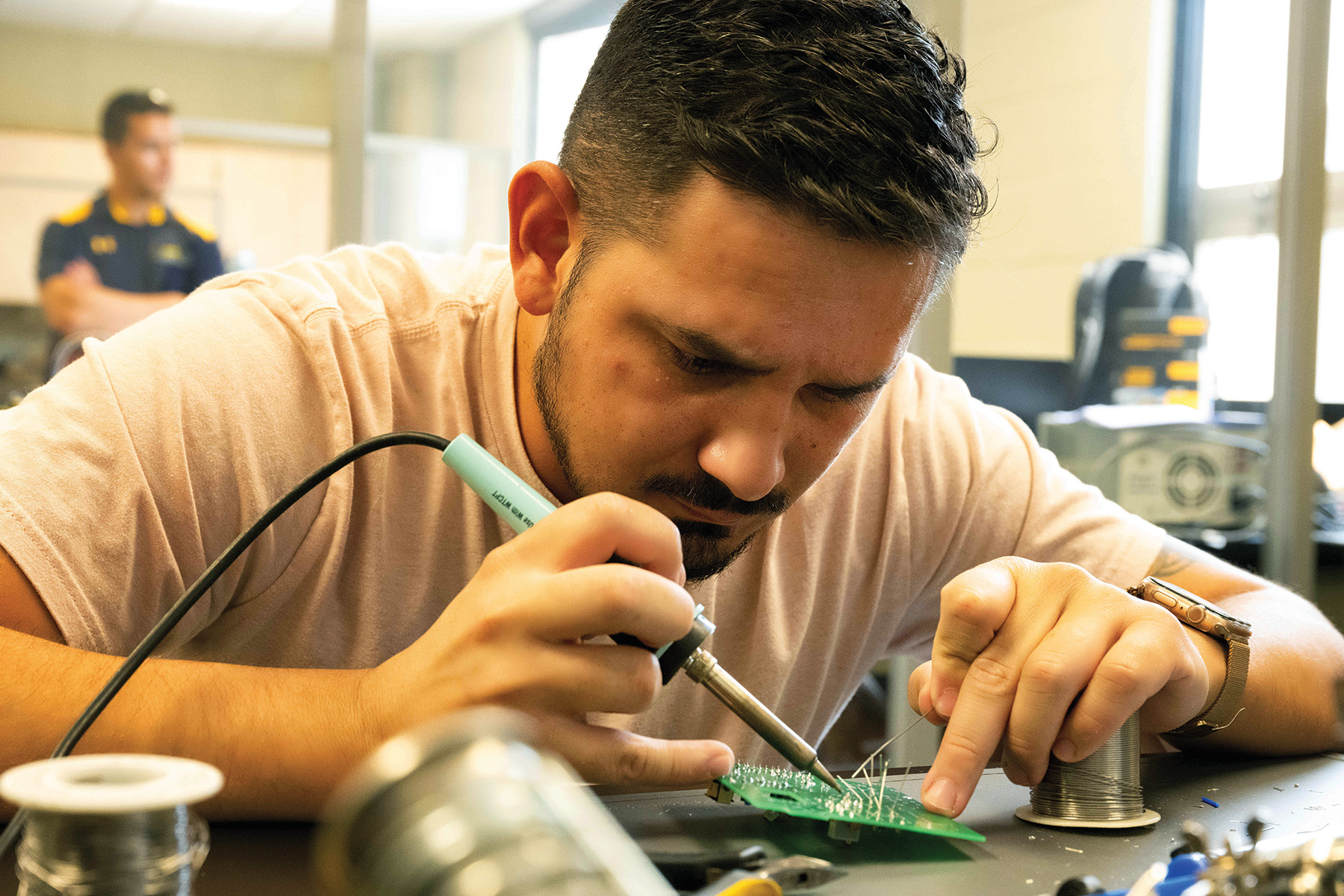
Jose Castelblanco, an engineering physics major with a spacecraft instrumentation concentration at Embry-Riddle Aeronautical University, works in Van Allen Hall during the first week of the Edge of Space Academy.
IT’S THE THIRD DAY of the Edge of Space Academy in Iowa City, and the students are well organized. The undergraduates are divided into three groups: One team will lead an instrument mission to analyze cosmic rays from space, while the other teams will oversee instruments placed on drones to conduct terrestrial observations such as 3D mapping and observing plant health. Each person has been assigned a distinct role—project manager, science lead, systems engineer, and launch coordinator—just like one would find on a multimillion-dollar agency mission.
The room on the third floor of Van Allen Hall is abuzz with excited, muted chatter and knuckle-down industriousness. Jaynes and fellow faculty members Susan Meerdink (Department of Geographical and Sustainability Sciences; an expert in Earth observation techniques) and David Miles (Department of Physics and Astronomy; space instrumentation expert) circulate the room, ready to answer questions. The students are situated at stations paralleling their roles—computer coding, soldering, flight route planning, instrument visualization, among others.
At one station, Raemalin Hancock peers intently at a screen. Her project involves instruments that will measure cosmic rays from space; she’s looking at a 3D model of the housing that will protect the instruments’ electronics. The student from El Paso Community College in Texas twists and turns the housing, examining it from different angles. This is the computerized blueprint from which the actual housing will be 3D printed, and Hancock wants to make sure everything is nice and tight.
“We need it to be stable, because it’s going up in a propeller plane, and it’s going to be a bumpy ride,” she says.
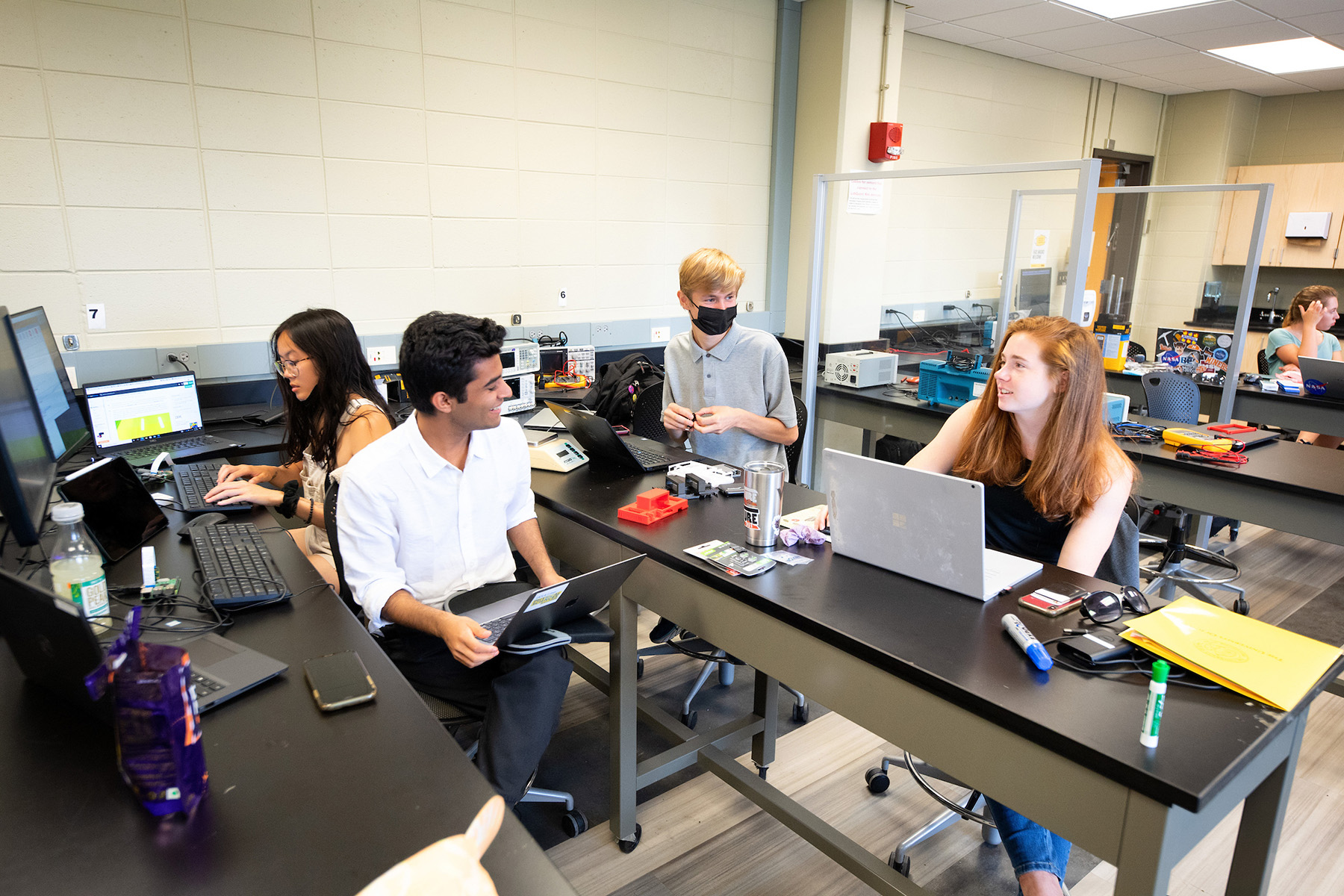
Tessa Vu, Aashman Rastogi, Simon Winter, and Jennifer Ochs work in Van Allen Hall during the first week of the University of Iowa’s Edge of Space Academy. The students are from the University of Utah, the University of California–Los Angeles, the University of Maryland–Baltimore County, and Virginia Tech University, respectively.
Hancock, who plans to transfer to a four-year institution to obtain a degree in mechanical engineering, learned about the Edge of Space Academy through a co-worker at Makerspace, a specialized lab at her college where students can learn technologies such as laser cutting, woodworking, and robotics. She applied to the Edge of Space Academy because she wanted to expand her skills, and she was enchanted by the idea of being part of a mission. Already, Hancock says the class has broadened her abilities.
“I’ve learned so many skills that I wouldn’t have had the guts to try on my own,” Hancock says. “They taught us how to solder to NASA specifications. They went deeper than most instructors would have.”
At another station, Alexa Houck is arched over a black bench, needle in hand. Thin, ribbony wisps of smoke curl upward as the rising senior from James Madison University bonds wires to an electronics circuit board. This is her first time soldering. It’s a brave choice, considering it is essential she properly connect the wires and electronics for the cosmic-ray instrument to successfully collect data.
“I really like doing hands-on things—that’s one of the reasons I’m in STEM,” Houck says. “Plus, I’ve never done soldering before, and I like trying new things,” she adds.
Houck envisioned the summer course as a way to help her reach her goal of working in aerospace engineering.
“I don’t have the traditional aerospace engineering background,” says Houck, an integrated science and technology student from Burke, Virginia. “The more skills I can rack up in that department, it will serve me better.”
“It’s awesome because these professors are such accomplished professionals in their fields. Our conversations have given me a lot of valuable insight and direction into how I might enter the space industry myself.”
THE DAY AFTER WORKING IN THE LAB, the students hear physicists, engineers, and other research scientists at Iowa talk about their experiences on space missions. For nearly seven decades, Iowa has been at the center of space research, from the discovery in 1958 by James Van Allen of radiation belts surrounding our planet, to the astonishing revelation in 2012 by Donald Gurnett that Voyager 1, a human-built spacecraft bearing his radio- and plasma-wave instrument, had exited our solar system and was sailing among the stars.
In all, Iowa researchers have designed or built instruments for 70 low-Earth or space missions. It’s a prolific output that includes trips to nearly every planet in the solar system (and more than once to some planets), detailed studies of the moon, sub-orbital rocket launches to study auroras on Earth, and instruments aboard CubeSats, the new generation of spacecraft the size of a loaf of bread.
From that long span of involvement has sprung a gusher of discoveries, including auroras on Jupiter (and other planets), new insights into Saturn’s rings, and eerie sounds in Earth’s upper atmosphere called “whistlers.” Iowa researchers have learned how Mars transformed from a wet to a dry environment, how the sun packs its blustery punch through the solar wind, and other meaningful findings that have advanced humanity’s understanding of our planet and the universe.
Currently, there are Iowa-produced instruments on 14 craft jetting somewhere around space. Soon, that number will be 15, when Craig Kletzing, the Donald A. and Marie B. Gurnett chair and professor of physics and astronomy, deploys a fleet of satellites to study the dynamic magnetic environment between the sun and Earth through NASA’s $115 million TRACERS mission, the single-largest external research award in university history.
The Edge of Space Academy students, all but one of whom came from out of state, knew little, if anything, about Iowa’s space legacy.
Amber Birdwell was one of them. That is, until the rising junior at the University of Southern California heard a parade of Iowa researchers discuss their projects, many of them NASA funded.
“It’s awesome because these professors are such accomplished professionals in their fields,” says Birdwell, who studies geographic information systems (GIS), urban planning, and architecture as part of her major in global geodesign. “Our conversations have given me a lot of valuable insight and direction into how I might enter the space industry myself.”
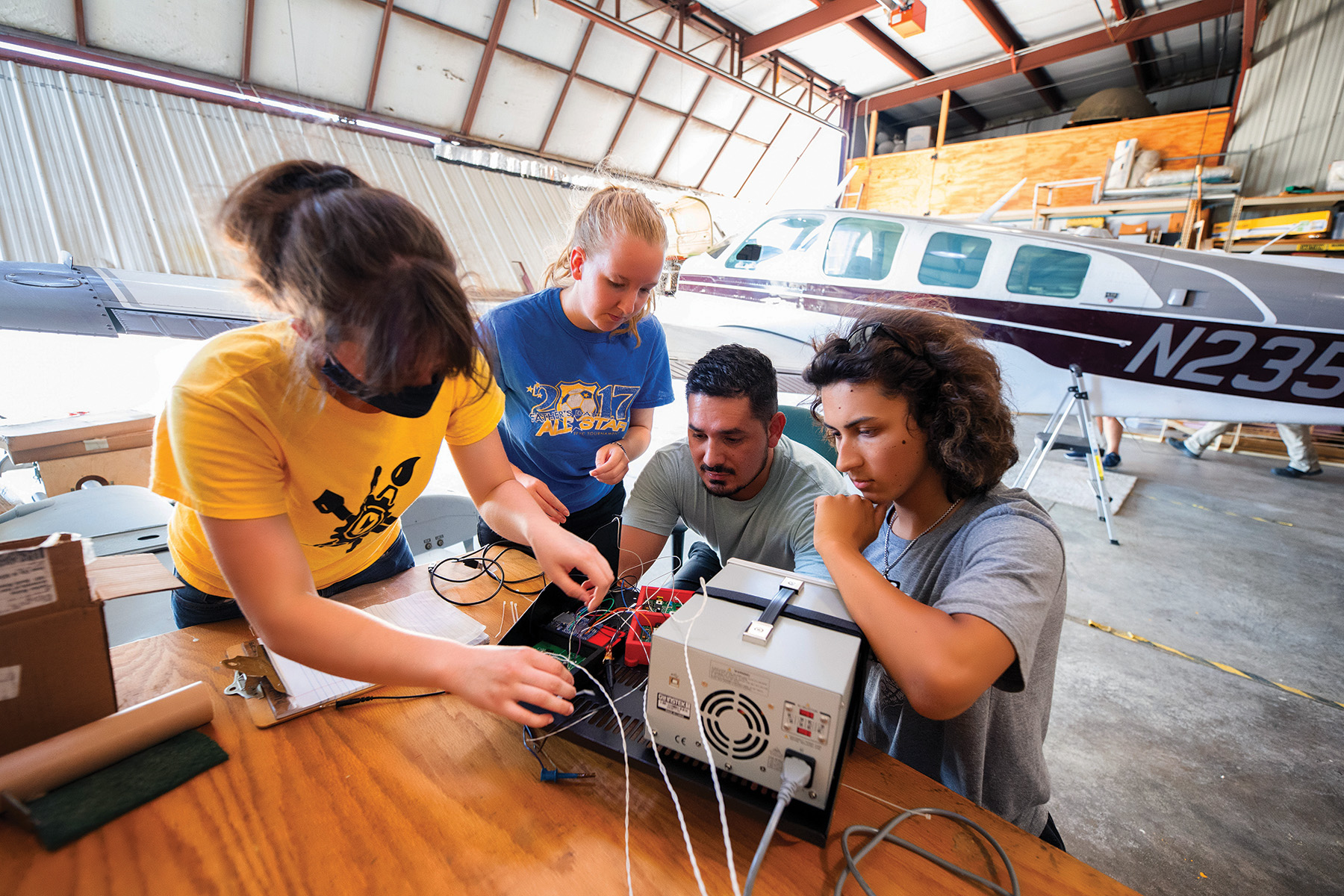
University of Iowa physics and astronomy undergraduate student Tino Smith (right) works with (from left) Raemalin Hancock, Alexa Houck, and Jose Castelblanco at the Operator Performance Laboratory as part of the Edge of Space Academy.
IT’S THE END OF THE FIRST WEEK, and flight day is here. The three groups have pushed themselves hard to get everything ready. Payload assembled? Check. Coding completed? Check. Computer reading signals from the instrument? Check. Flight path determined? Check.
As can happen in a real mission, problems arise. At the Iowa City Municipal Airport, the space crew’s first flight has been scrubbed. The pilot, Thomas Schnell, director of the Operator Performance Laboratory at Iowa, has determined there will be too much turbulence at the altitude necessary to fulfill the experiment. Then, another setback: Schnell informs the space group that its placement of high-voltage boards on the cosmic-ray instrument could cause a fire. So, the team must regroup quickly and redesign the part.
Meanwhile, the Earth-observing teams are confronting their own challenges. One is using a 3D digital mapping technology called LiDAR, while the other is employing cameras to take pictures in near-infrared and visible wavelengths. The two groups gather under low-hanging clouds at Ashton Prairie, the cross-country course where the university has reintroduced several acres of native tallgrass prairie. Mary De La Garza, a digital archaeologist with the Office of the State Archaeologist, stands ready to pilot the drone. The student groups lay out a grid using alphabetized placards and will instruct De La Garza where to fly.
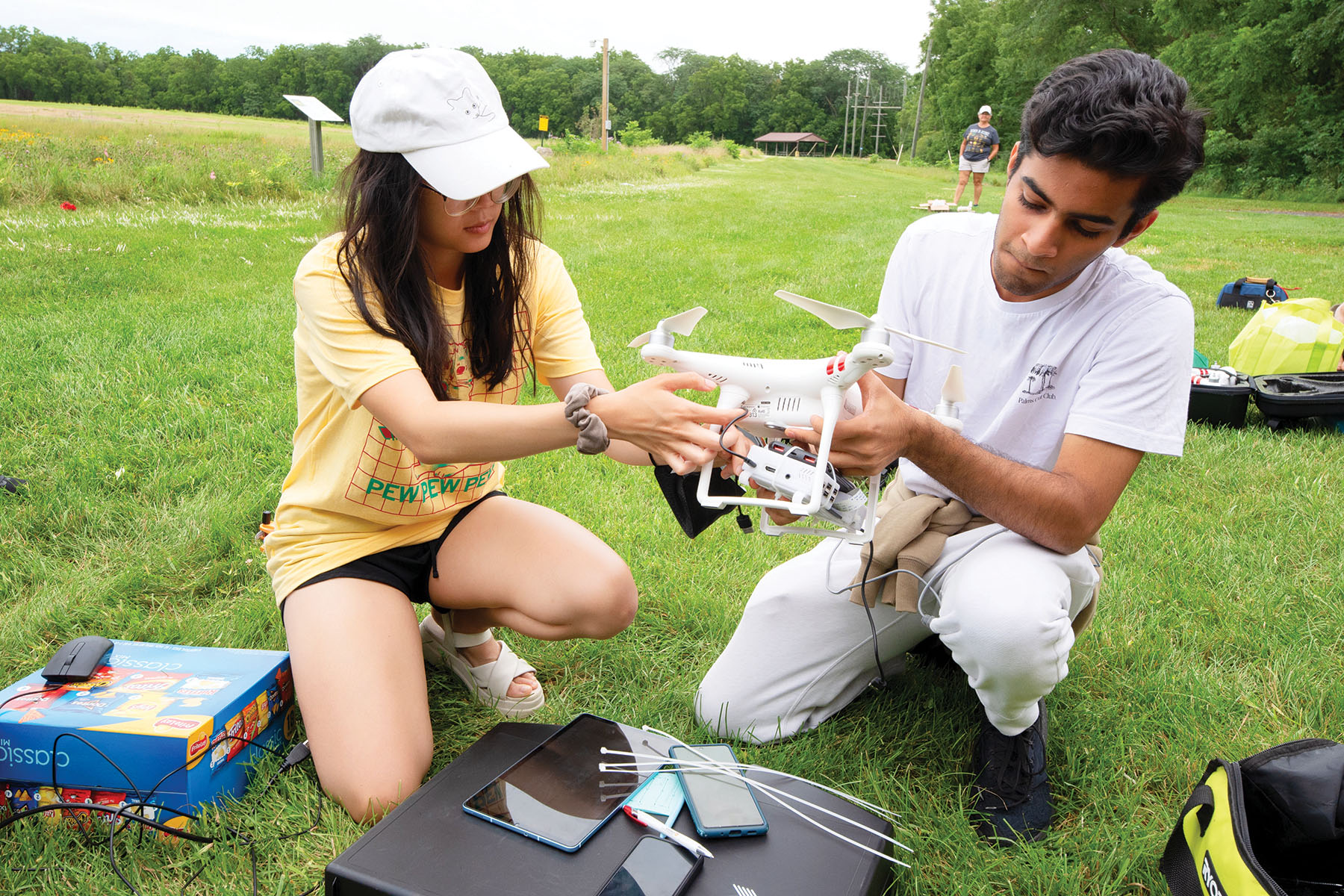
Tessa Vu and Angel Gonzalo Soto prepare instruments to conduct terrestrial observations during an exercise at the Edge of Space Academy.
The groups quickly learn that conditions in the field do not match conditions in the lab. The LiDAR group fastens its instrument to the drone but loses the signal between the instrument and the computer on the ground. The four group members, huddled together, now must troubleshoot on the fly. Is it an error in the code? The placement of the zip ties? The issue turns out to be a simple one: Meerdink notices the students hadn’t plugged the instrument into an electrical outlet.
Birdwell, who just moments ago had thrust her hands in her hair in anguish, is relieved.
“Oh, I was really panicking,” she admits sheepishly.
A short distance away, the camera group was batting away its own frustrations. The team’s first flight attempt was grounded due to too many ground markers and sudden wind gusts. On the second attempt, an alert that a medical helicopter was inbound to UI Hospitals & Clinics aborted the drone flight.
The morning waltzes on. The students sustain themselves with chips, water, and Powerade brought by the class instructors, along with multiple helpings of moral support. By the afternoon, their perseverance has been rewarded. Both groups have managed successful flights. Now, it’s back to campus to analyze their data.
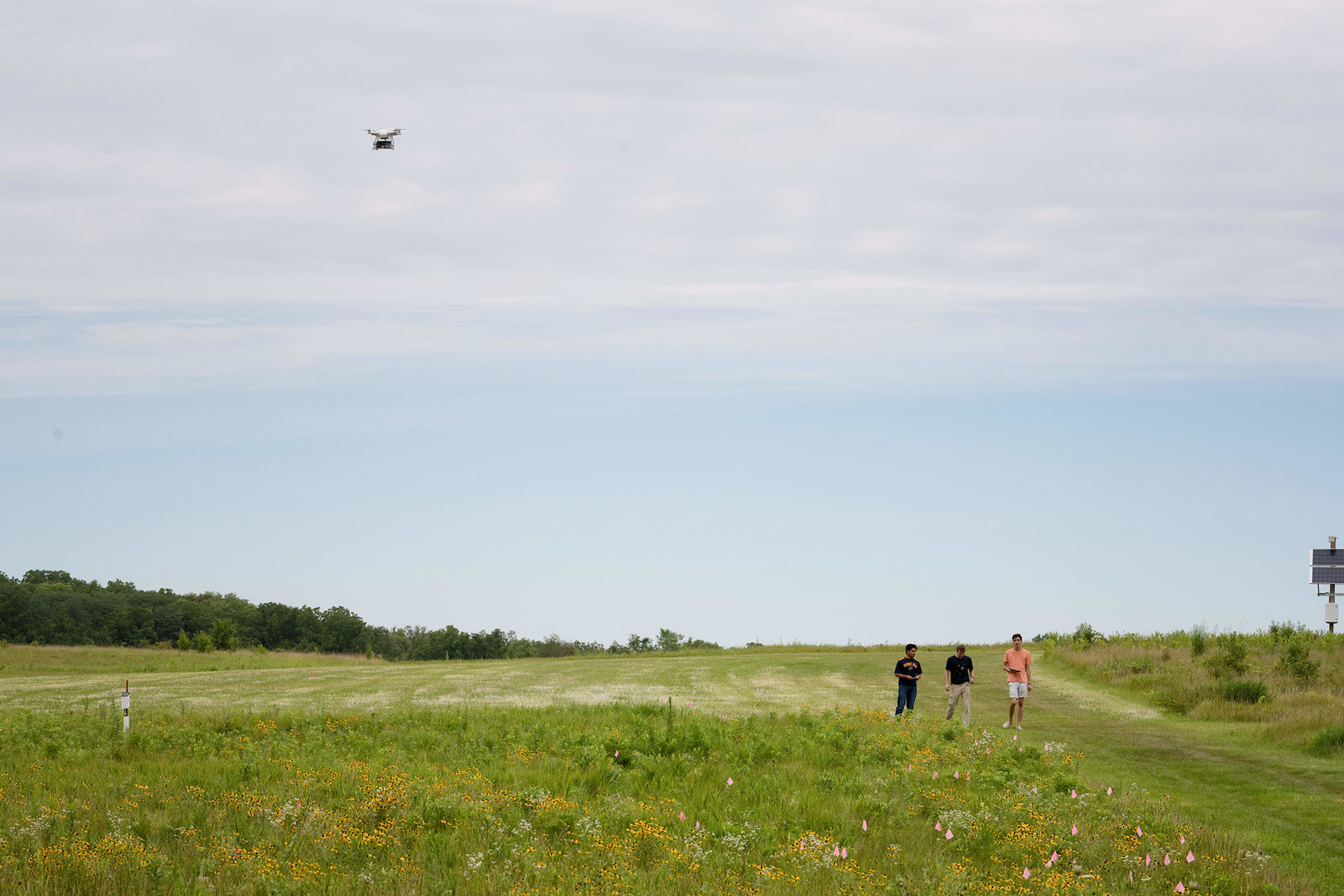
“If you’re looking for knowledge or to get experience in space or be part of a mini-mission, this is the place to do it.”
IT’S THE PENULTIMATE DAY of the Edge of Space Academy, and the students have gathered in a classroom with Jaynes and Meerdink to talk about their experiences in the class. The conversation is light and animated, with frequent bursts of laughter. Each group succeeded in sending a payload airborne, obtaining data, and making sense of the science. The groups displayed their results at an undergraduate research conference sponsored by the Graduate College. Missions accomplished. Now, they can relax.
Jaynes asks the class whether the academy has changed their career plans. Several respond yes, including Sebastian Oropeza, who studies mechanical engineering at the University of Texas-El Paso.
“It’s opened my mind,” says Oropeza, a member of the LiDAR group. “I was thinking about graduating, then going to a company. Now, I see I can do a research project and travel the world. This class was so cool, I want to do more of that.”
“You don’t have to take a straight, prescribed path to get where you want to go,” Jaynes replies.
Meerdink broaches the idea of furthering their studies in a graduate program. She tells the class about her own experience, a farm girl from rural, northwest Iowa who was the first in her family to pursue a graduate degree. Meerdink’s tuition and expenses at the University of California-Santa Barbara were all paid, she says, and she worked at NASA’s Jet Propulsion Laboratory as she earned a doctorate in geography.
Jose Castelblanco says he was satisfied with his two weeks in Iowa City. He plans to tell his peers at Embry Riddle Aeronautical University about the class, and he’s considering Iowa for graduate school.
“If you’re looking for knowledge or to get experience in space or be part of a mini-mission, this is the place to do it,” says Castelblanco, an Army veteran from Wesley Chapel, Florida.
Hancock, meanwhile, admits she’s still trying to take stock of the two-week whirlwind.
“It’s still sinking in, what I’ve accomplished,” she says. “Very few people can say they’ve launched a project of theirs on a plane. I still have flight data downloaded on my computer to mark the path they took.”
Yes, planning and executing a mission in 10 days is arduous. Yes, the students at times seemed overwhelmed. But that was by design.
As Jaynes says, “That’s how all real-life [NASA] missions are conducted.”
